- Author Matthew Elmers [email protected].
- Public 2023-12-16 21:49.
- Last modified 2025-01-24 09:17.
The Bell XV-3 is an American experimental tiltrotor. It made its first flight on August 23, 1955. The first transition from vertical to horizontal flight was on December 18, 1958. In total, more than 250 test flights were completed by 1966, which proved the fundamental possibility of creating a tiltrotor with rotary screws. The tests of this aircraft were recognized as successful, so it was decided to create on its basis an apparatus already with rotary engines, which led to the creation of the Bell XV-15 tiltrotor.
The experimental Bell XV-3 had a large fuselage designed for 4 passengers, fixed wings with a span of 9.54 meters and a Pratt & Whitney R-985 engine, which developed a maximum power of 450 hp. The rotor-propeller, which was located on the console of each wing, was transferred to the required position with the help of electric motors: upward for vertical flight, forward for horizontal flight.
In order to obtain an aircraft that could combine the features of an aircraft and a helicopter, many attempts were made to create a variety of rotary-wing machines, including those with rotary propellers, which in the west were called tiltrotor, and in our country - a helicopter-aircraft. These aircraft were equipped with large-diameter rotary propellers with articulated blades and a small load on the swept area, like in helicopters, which provided such machines with the ability to perform vertical take-off with a relatively low power of the engine installed on them.
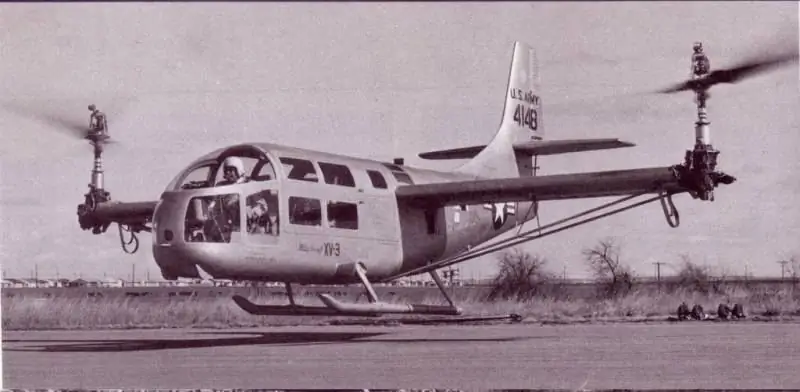
The tiltrotor propellers were driven directly from the engines, which could be installed in the nacelles, turning with the propellers, or from the engine / engines, which were located in the fuselage of the vehicle or in separate nacelles, while only the propellers turned when switching to another flight model. During horizontal flight, the tiltrotor was controlled like an airplane - with the help of ordinary aircraft controls, and when switching to vertical flight - like a helicopter, with the help of controlling the total and cyclic pitch of the propellers. It was assumed that in the event of a power plant malfunction, tiltrotors would be able to land like an airplane with planning and partial inclination of the propellers, or, like a helicopter, in autorotation mode.
Tiltrotor Bell XV-3
For many years, the Bell company has carried out a large amount of research and experimental work in the field of tiltrotor creation, the work in this direction was led by designers Arthur Young and Bertrand Kelly, later Robert Lichten joined them. At the 1950 US Army competition for the best aircraft design for frontline reconnaissance and rescue services, Bell presented a tiltrotor design with tilt rotor propellers. In total, the commission considered 17 different projects, of which only 3 projects of rotary-wing aircraft were selected, including the project of the designers of the "Bell" company. As a result of the competition held in 1951, the US Air Force signed a contract with this company for the construction of two experimental converters for subsequent flight tests of the vehicles.
The construction of the first Bell tiltrotor, which initially received the designation Bell XH-33, and later Bell XV-3, was delayed, the work was completed only at the beginning of 1955, and on February 10 of the same year the first official demonstration of the novelty took place. On August 11, 1955, the first vertical take-off and hover flights took place, and then transitions to horizontal flight, when the propellers tilt reached 15 degrees (test pilot Floyd Carlson). In the subsequent tests of the tiltrotor, which took place on October 25, 1956 in the air at an altitude of 60 meters with the propellers tilted by 20 degrees, the device lost control due to mechanical instability and fell, while Bell XV-3 was destroyed, and test pilot Dick Stensbury as a result of the fall, he was seriously injured.
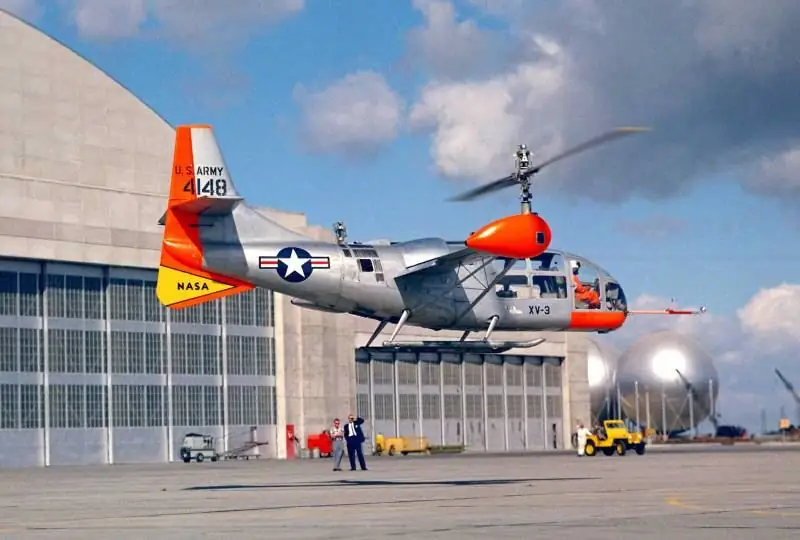
Due to the disaster, further flight tests of the tiltrotor continued only in 1958 on the second instance of the Bell XV-3. At first, it had two-bladed propellers, but soon they were replaced by three-bladed ones. For the first time, a full transition from vertical flight to horizontal flight with subsequent vertical landing was carried out on December 18, 1958, in this flight the tiltrotor was controlled by test pilot Bill Quinlen. In subsequent flights, the device was able to reach a speed of 212 km / h at an altitude of 1220 meters. In 1962, this unit was transferred for further testing at the NASA Langley Research Center. In this center, Bell XV-3 successfully flew in vertical modes and performed incomplete transitions to airplane mode with a propeller pitch of 30-40 degrees.
Also, the tiltrotor was tested on a special stand, where a full transition to the "airplane" flight mode was performed. When switching from a helicopter flight mode to an aircraft one, the propellers were tilted 90 degrees using a worm gear from electric motors. The transition process usually took only 15-20 seconds. At the same time, the Bell XV-3 tiltrotor was able to continue flying at any intermediate position of the propellers during the transition. In total, this tiltrotor has performed more than 250 test flights and 110 full transitions between flight modes, having flown about 450 hours during this time. During these flights, a maximum speed of 290 km / h was reached, as well as an altitude of 3660 meters. Tiltrotor tests continued in 1965, but already in a wind tunnel. These tests were stopped due to the detachment of the nacelle with the propeller and the damage received by the Bell XV-3.
The Air Force and the US Army had very high hopes for the development of this type of aircraft, believing that converters are best suited for reconnaissance, communications and rescue operations. Bell has created a number of projects for both military and civilian models of such rotary-wing aircraft. On a number of them, it was planned to install two gas turbine engines located in gondolas under the wing, while the maximum speed was supposed to be about 400 km / h.
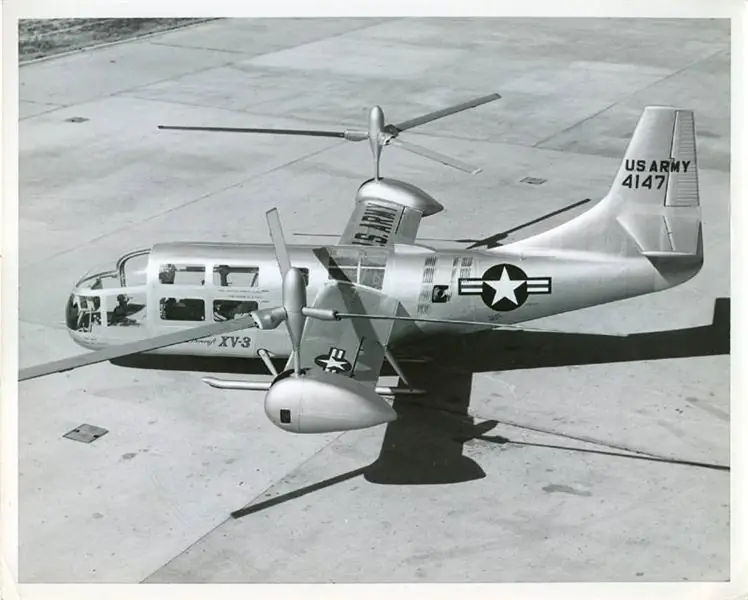
The Bell XV-3 tiltrotor had the same layout as conventional aircraft. The most simple and suitable was the layout, in which the propellers were located at the ends of the wings: when they were turned, the tiltrotor became similar to a twin-rotor transverse helicopter. During vertical take-off, the flow from the propellers was inhibited, blowing over the wing, which was the reason for the loss of propellers in thrust, and the maximum speed of the tiltrotor was relatively small due to the low power-to-weight ratio of the experimental aircraft.
Externally, the experimental Bell XV-3 tiltrotor is a monoplane with one engine and two rotary three-blade propellers, as well as a skid landing gear of a very simple design, the chassis track was 2, 8 meters. At the same time, the aircraft fuselage was distinguished by good aerodynamic shapes. In its bow there was a cockpit with a large glazing area. In this cabin there were a pilot, co-pilot or observer, as well as two passengers, instead of them it was possible to place a wounded person on a stretcher with an orderly. The wing of the tiltrotor was straight and had a relatively small area, since it was calculated to create lift only at cruising flight speed. At the ends of the wing were small gondolas with rotary screws. The wing tip sheathing could be removed by technical service representatives to gain access to the transmission components. The wing also had retractable flaps and ailerons. The tail unit was the same as that of conventional aircraft - with a rudder, with a large vertical tail area, on the keel there was a stabilizer with a span of 4 meters with elevators.
Due to its design, the Bell XV-3 tiltrotor had a number of unique operational features. For example, the cross transmission, which was typical for multi-engine aircraft, was absent. In the event of a failure of the power plant, the Bell XV-3 propellers were automatically brought to a vertical position, as a result of which the tiltrotor could descend on autorotation like an ordinary helicopter or a conventional gyroplane. At the same time, the propellers bent forward to create thrust, however, during horizontal flight, part of the lift was still created by the wing of the vehicle.
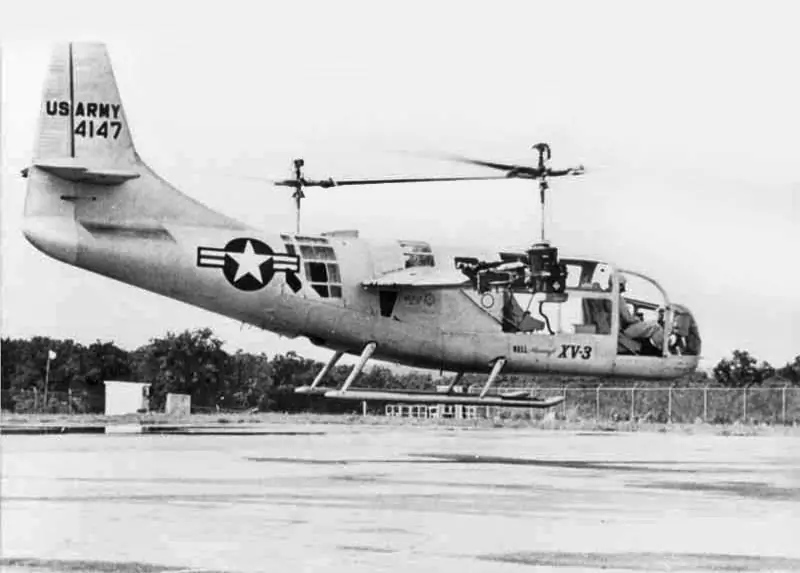
The most difficult thing for Bell engineers was the selection of propellers of the optimal diameter for the Bell XV-3 tiltrotor. The thing was that large-diameter propellers were needed for vertical take-off of the vehicle, while in horizontal flight it was more profitable to use small propellers. Ultimately, the compromise diameter of the turning screws was 7.6 meters. Three-blade propellers of this diameter were located in nacelles at the wing tips. The screw sleeves had intersecting vertical and horizontal hinges located at a distance of 0.44 meters from the axis of rotation, as well as swing compensators. The propeller hubs were covered with fairings. All-metal glued blades in plan had a rectangular shape and a geometric twist of 20 degrees.
The experimental Bell XV-3 tiltrotor was powered by a Pratt & Whitney air-cooled radial piston engine. It was the R-985-AN-1 and the engine had a maximum power of 450 hp. at 2300 rpm at an altitude of 450 meters and during takeoff. The engine was installed in the central part of the fuselage. Due to the insufficient power of the power plant, the maximum speed was limited to 280 km / h, although the tiltrotor showed a greater value during tests. Achieving higher speed was possible by replacing the engine with a more powerful one. In particular, there were plans to install a twin-shaft GTE Lycoming T-53, which developed a power of 825 hp.
After the completion of the Bell XV-3 tests, the idea of a tiltrotor was not abandoned in the United States. After him, a new model was born. The new aircraft was equipped with already rotating engines. It received the designation Bell XV-15 and made its maiden flight in May 1977. And on March 19, 1989, the Bell V-22 Osprey tiltrotor took off into the sky, which has been in service since 2005. He serves in the Marine Corps and the United States Air Force Special Operations Command. As of 2016, more than 300 vehicles of this type have been built, and the supply of these converters to the US armed forces continues.
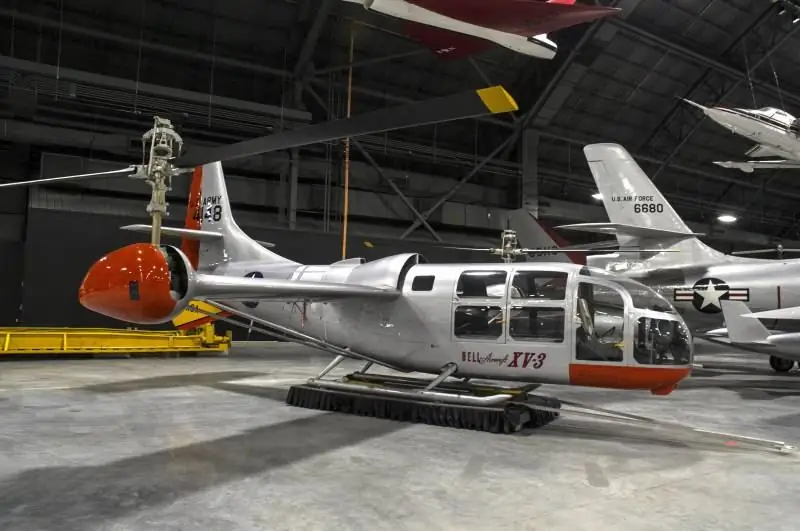
Flight technical characteristics of the XV-3 tiltrotor:
Overall dimensions: length - 9, 2 m, height - 4 m, wingspan - 9, 5 m, diameter of rotary screws - 7, 6 m.
Empty weight - 1907 kg.
Takeoff weight - 2218 kg.
The power plant is a Pratt Whitney R-985-AN-1 theater with a capacity of 450 hp.
The maximum speed is 290 km / h.
Cruising speed - 269 km / h.
Practical range - 411 km.
Service ceiling - 4600 m.
The rate of climb is 6, 3 m / s.
Crew - 1 person.






